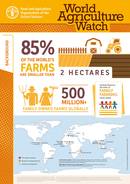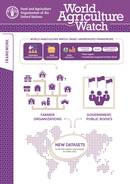Selected publications
There are more than 85% of the world’s farms are smaller than 2 hectares and more than 500 million family-owned farms globally. Farms, especially family farms, are highly diverse and generally have limited capital to invest unless they mobilize their own labour force (human capital). Unequal access to assets (natural, physical, social, human or financial) means farmers have varying ability to engage in different types of on- and off-farm activity. To be inclusive, we need to better target investment for all types of farm.
World Agriculture Watch (WAW) offers a comprehensive approach and tools to examine, analyse and monitor agricultural transformation around the world, to identify patterns and drivers of change and assess their impact. While WAW collects data on all types of farm, including industrial agriculture, it pays particularly close attention to family farms, to better tackle the constraints on their development through investment policies.
There are three stages in total for actions of WAW programme, which are CONSOLIDATED FARM DATA, INVESTMENT STRATEGIES, and NATIONAL OBSERVATORIES.
To scale up the initiative, WAW plans to rely on the involvement of numerous interconnected networks and hence will contribute to SDG 17 by strengthening partnerships between CSO, Governments and the private sector. Country projects will be undertaken in 21 countries in which there are around 100 regional observation sites established. WAW also partners with rural producer organizations, national farmer platforms and regional organizations. It works with non-governmental organizations (NGOs) to strengthen the capacity of small support and cooperative groups.
Farms and farming households help shape the dynamics of an area, as farming and other activities are based on interaction with natural resources. Decision-making at household and farm level, therefore, takes place in a territorial context, framed by a particular set of resources. These, in turn, will impact the natural assets of the farm and the territory more widely. WAW is a tool for building inclusive investment and social policies and uses statistically representative benchmark farms to scale up results to the territorial level.






